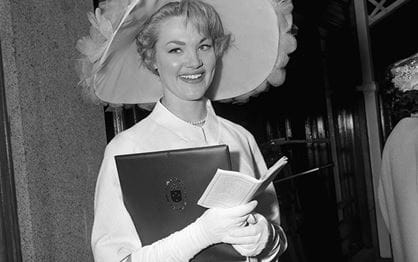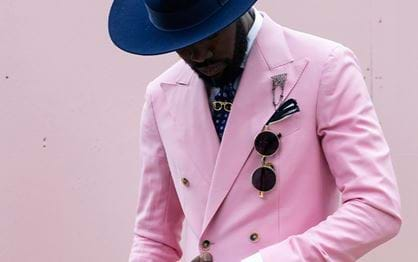The classic photograph of Jean Shrimpton at Flemington on Derby Day in 1965 shows a fresh-faced young woman, her hair loose and flowing in the breeze. In a sleeveless white minidress, its hemline hovering four inches above the knee, the 22-year-old British supermodel looks the picture of 1960s elegance and simplicity, carefree and independent with no stockings, no gloves and no hat.
This iconic image of Shrimpton captures a watershed moment in Australian fashion, highlighting the rapid changes taking place in the ‘60s. Far away from such fashion capitals as London and Paris, Australia had never seen such a daringly short skirt, and Shrimpton’s faux pas made international headlines. This, as Shrimpton observes in her memoirs, “was how the mini was born”.
With her classic, doll-like features, fashion magazines regularly proclaimed Shrimpton ‘the most beautiful girl in the world’. She was one of the most recognisable faces of Swinging London, and the centre of a trio of supermodels that included Twiggy and Veruschka. In 1965, she was the highest-paid model in the world, and her appearance at Flemington as a judge of Fashions on the Field would bring international glamour and prestige to the event.
When she arrived in Australia for her two-week promotional visit, Shrimpton was utterly unaware of the scandal she would soon cause. As she recalls in her memoirs, DuPont International had sent her lengths of their newly popular fabric, Orlon, to have some “smart, race-going outfits” made up from. She enlisted the dressmaker Colin Rolfe to have her designs made, only they soon discovered a problem – there was not quite enough fabric. Still, Shrimpton was unconcerned, and told Rolfe, “Oh, it doesn’t matter. Make them a bit shorter – no one’s going to notice.”
Shrimpton was oblivious to the requisite accessories at Flemington – stockings, hat and gloves – and, as the morning of Derby Day was quite warm, she simply slipped on some low-heeled slingback shoes and an ankle chain and was ready to go. “I had no hat or gloves with me, for the very good reason that I owned neither,” she recalls. “I went downstairs cheerfully from my hotel room, all regardless of what was to come.”
Almost immediately upon her arrival, she realised her mistake. There was tut-tutting all over the racecourse, and reporters clamoured to get a photograph. “I was surrounded by cameramen, all on their knees like proposing Victorian swains, shooting upwards to make my skirt look even shorter,” Shrimpton wrote. “This was publicity that I certainly had not planned.”
The story spread around the globe, and Shrimpton was publicly criticised. Former Lady Mayoress of Melbourne Lady Nathan declared, “If Miss Shrimpton wants to wear skirts four inches above the knee in London, that's her business, but it's not done here ... We all dress correctly here.”
Maggi Eckardt was an Australian model at the time who had recently returned from living in Paris, London and New York, (Maggi passed away at the age of 82 in May 2020). She remembered the 1965 Melbourne Cup Carnival vividly. “I’ll never forget that image of Jean, with all these very conservative women looking down their noses at her, and she had her head held high, smiling,” Eckardt said. “She looked like a breath of fresh air. We were used to seeing that look in Europe so we never queried it, but Australia in those days was a long way away. They caught up with fashions after they were shown everywhere else. These days everything comes out at the same time, so you get the fashions from Paris immediately and there's not that gap, but everything was much more conservative back then.”
To make up for the scandal she had caused, Shrimpton appeared on Melbourne Cup Day in a more demure outfit – a three-piece grey suit, dressed up with a chocolate-brown handbag, an ice-blue straw Breton hat, beige gloves and stockings. Eckardt was awarded Most Elegant Hat for her unique, zebra-patterned turban in Fashions on the Field, and was delighted to find her friend presenting the award to her.
“I knew Jean through photographic jobs in the UK,” Eckardt said. “We’d worked together with David Bailey, and when you’re on the circuit in modelling you know the other girls around. It’s quite a small world.”
“She presented me with the prize and I remember we had to shake hands, and she said, ‘I don’t believe this – me giving you a prize?’ She was surprised to see me in Australia, and I didn’t know she was coming either, so it was a lovely moment.
When Rebecca Judd donned a replica of Shrimpton’s famous Derby Day outfit for a photo shoot in 2009, it seemed strikingly demure – which highlights how much racing fashion has evolved, thanks in part to Shrimpton bringing the minidress to Australia. Despite the initial backlash, her short dress made a real impact on the changing fashion landscape. As she recalled in her autobiography, the end result of the scandal was that all over Australia, young girls started shortening their skirts. “The pictures which the British newspapers used had the same results back home,” Shrimpton wrote. “Suddenly the mini, which had a half-hearted start in Paris, became fashionable.”









